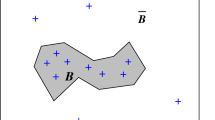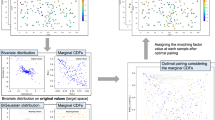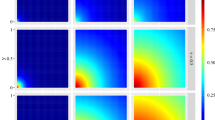Abstract
Traditionally, spatial continuity models for indicator variables are developed by empirical curvefitting to the sample indicator (cross-) variogram. However, geologic data may be too sparse to permit a purely empirical approach, particularly in application to the subsurface. Techniques for model synthesis that integrate hard data and conceptual models therefore are needed. Interpretability is crucial. Compared with the indicator (cross-) variogram or indicator (cross-) covariance, the transition probability is more interpretable. Information on proportion, mean length, and juxtapositioning directly relates to the transition probability: asymmetry can be considered. Furthermore, the transition probability elucidates order relation conditions and readily formulates the indicator (co)kriging equations.
Similar content being viewed by others
References
Allen, J. R. L., 1970, Studies in fluviatile sediments: a comparison of fining-upward cyclothems with special reference to coarse-member composition and interpretation: Jour. Sed. Pet., v. 40, no. 1, p. 298–323.
Armstrong, M., 1992, Positive definiteness is not enough: Math. Geology, v. 24, no. 1, p. 135–143.
Christakos, G., 1984, On the problem of permissible covariance and variogram models: Water Resources Research, v. 20, no. 2, p. 251–265.
Dagan, G., 1989, Flow and transport in porous formations: Springer-Verlag, New York, 465 p.
Deutsch, C. V., and Journel, A. G., 1992. GSL1B: Geostatistical Software Library: Oxford Univ. Press, New York, 340 p.
Goovaerts, P., 1994a, Comparison of ColK. IK. mIK performances for modeling conditional probabilities of categorical variables, in Dimitrakopoulos, R., ed., Geostatistics for the next century: Kluwer Academic Publ., Dordrecht, p. 18–29.
Goovaerts, P., 1994b, Comparative performance of indicator algorithms for modeling conditional probability distribution functions: Math. Geology, v. 26, no. 3, p. 389–411.
Horn, R. A., and Johnson, C. R., 1991, Topics in matrix analysis: Cambridge Univ. Press, New York, 607 p.
Journel, A. G., 1983. Nonparametric estimation of spatial distributions: Math. Geology. v. 15, no. 3, p. 445–468.
Journel, A. G., 1993, Modeling uncertainty: some conceptual thoughts,in Dimitrakopoulos, R., ed., Geostatistics for the next century: Kluwer Academic Publ., Dordrecht, p. 30–43.
Journel, A. G., and Alabert, F., 1989. Non-Gaussian data expansion in the earth sciences: Terra Nova, v. 1, no. 2, p. 123–134.
Journel, A. G., and Huijbregts, 1978, Mining geostatistics: Academic Press, San Diego, California. 600 p.
Journel, A. G., and Posa, D., 1990, Characteristic behavior and order relations for indicator variograms: Math. Geology, v. 22, no. 8, p. 1011–1025.
Leeder, M. R., 1982, Sedimentology: George Allen & Unwin Ltd. London. 344 p.
Miall, A. D., 1973, Markov chain analysis applied to an ancient alluvial plain succession: Sedimentology, v. 20, no. 3, p. 347–364.
Myers, D. E., 1982. Matrix formulation of co-kriging: Math. Geology, v. 14, no. 3, p. 249–257.
Pawlowsky, V., 1989, Cokriging of regionalized compositions: Math. Geology, v. 21, no. 5, p. 513–521.
Pawlowsky, V., Olea, R. A., and Davis, J. C., 1995, Estimation of regionalized compositions: a comparison of three methods: Math. Geology, v. 27, no. 1, p. 105–127.
Press, W. H., Teukolsky, S. A., Vetterling, W. T., and Flannery, B. P., 1992. Numerical recipes in FORTRAN: Cambridge Univ. Press, New York. 963 p.
Ross, S., 1988, A first course in probability: Macmillan Publ. Co., New York. 420 p.
Solow, A. R., 1986, Mapping by simple indicator kriging: Math. Geology, v. 18, no. 3, p. 335–352.
Author information
Authors and Affiliations
Rights and permissions
About this article
Cite this article
Carle, S.F., Fogg, G.E. Transition probability-based indicator geostatistics. Math Geol 28, 453–476 (1996). https://doi.org/10.1007/BF02083656
Received:
Accepted:
Issue Date:
DOI: https://doi.org/10.1007/BF02083656




